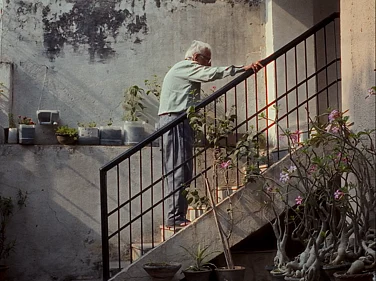The 2004 Kurdish drama Turtles Can Fly examines war through its most hapless victims: kids. Orphans Agrin (Avaz Latif) and Hengov (Hiresh Feysal Rahman) live in a refugee camp on the Iraq-Kurdish border. Agrin looks lost in thought; Hengov has lost his limbs. He wants to flee the camp; she covets the ultimate escape—suicide. Both of them, hardly in their teens, navigate the war-ravaged terrains like worn-out veterans: nothing gives them joy; nothing surprises them (especially as, in a brilliant bit of magical realism, Hengov has the ability to predict the future).
Filmmaker Bahman Ghobadi captures the tiered trauma of the war—that it is never truly over; it just finds new forms—through a toddler, Riga (Abdol Rahman Karim). Agrin and Hengov introduce him as their “little brother”. But we find out much later that he is, in fact, Agrin’s son. A child born out of a ‘warlock’—the son of a mother raped by Ba’ath soldiers. She considers Riga a blot—a harrowing reminder of her past, so much so that she wants to leave the camp without him—but Hengov sees in his nephew another child, another life, someone who deserves compassion. Such war-induced polarities—bringing out the best and worst in people—emerge in a scene where Agrin talking about abandoning the child is juxtaposed with Hengov fixing the bandage on Riga’s nose with limp limbs.
This tussle between light and darkness, centered on kids, informs another film set in conflict-ridden Afghanistan, The Kite Runner (2007). Like Hengov, Hassan (Ahmad Khan Mahmoodzada), a pre-teen boy, is a clairvoyant in his own right, accurately predicting the locations of falling kites. Hassan’s best friend, Amir (Zekeria Ebrahimi), is also his ‘master’. (His father has been a long-time servant of Amir’s old man.) But this hierarchy doesn’t distort their bond. Hassan and Amir play with each other, making an unlikely pair: Amir cuts kites; Hassan retrieves them for him—with a smile and a promise: “For you, a 1,000 times over.”
Like Turtles Can Fly, The Kite Runner features kids wrecked by war. A devastation so psychologically complete that it makes them act—or not act—in ways they wouldn’t have imagined. This very reason not just propels the film’s plot but also justifies its existence. On one of his kite-catching sprees, Hassan is caught by a gang of local boys who thrash and rape him. Amir sees it all from a distance but, presumably frozen by fear, remains frozen to his spot, then flees. This guilt haunts him in ways that he can’t process, and he contrives another cruelty to make Hassan and his father leave the house. The guilt returns to him in a pithy message decades later that sounds like a metaphorical appeal for pacifism and hope—that, despite everything, some amends can still be made: “There’s a way to be good again.”
War films centered on children also show what we lose—or risk losing. Take, for instance, the Japanese animated classic The Grave of the Fireflies (1988). Two kids, Seita and Setsuko, are as devastated by the Second World War as their city. Their mother has died; their father has disappeared. They leave their aunt’s house after a series of insults, seeking refuge in an abandoned bomb shelter. Yet late in the night, amid all the misery, pain, and despair, the siblings steal light by releasing fireflies under the sky. Setsuko, the toddler, beams at their sight, enduring the days to relish the nights. In a world ravaged by adults, suggests the film, children remind us that joy is not as distant, or complicated, as we make it out to be. Many times it is simple, spontaneous, innocent, demanding nothing more than few blobs of fire.
This heartbreaking juxtaposition—between consequential and trivial, depravity and simplicity, war and peace—forms the heart and spine of this Japanese classic. Because despite all the deaths and destruction, Setsuko gravitates towards joy like a moth finds its fire. As a result, unbothered by her aunt’s cruelty, she’s more excited by the new house, imagining an entrance, a living room, a life. She continues to respond to the world, marvelling at a comb, splashing on the beach, sleeping on her brother’s lap. By focusing on these seemingly mundane details, director Isao Takahata shows us the ultimate cruelty of war: that it destroys innocence, hope, and future; stifles a story even before it has begun; and punishes people for no fault of theirs. It’s also why an impressive war film featuring kids elicits a guttural, lasting feeling. Besides, to sympathise with children we don’t need the crutch of ideologies or degrees or 10-dollar words, all we need is a beating, bleeding heart—something we’ve forgotten to open.
If Setsuko reveals one side of the war, then Seita finishes the other: children forced to become adults. Barely a teenager himself, he takes care of her sister like a mother and a father, ensuring food, safety, shelter and, whenever possible, some tomfoolery and distraction. He steals food and goes to jail, suffers beating and swallows humiliation, becomes angry and turns bitter. A joyous Setsuko can make you forget that Seita, too, is just a child. Perhaps Takahata also shares this hunch because, at one point, the camera closes in on his body, and we see a scar-ridden back. The movie unfolds as a two-pronged tragedy: the first depicts a devastating death, of someone who couldn’t live her future, and the other captures a frozen childhood, of someone who can’t enjoy his present.
If there’s one film, however, that both distils the horror of war and the verve of children, then it’s Roberto Benigni’s Life is Beautiful (1997). It tells the story of an Italian waiter, Guido (Benigni), and his five-year-old son, Giosuè (Giorgio Cantarini), imprisoned in a Nazi concentration camp, where the father devises an ingenious plan to not just survive but also live. Guido informs Giosuè that it’s all a game—that the first one to score 1,000 points will win a tank. They’ll lose points, though, for misbehaving, such as “crying”, “wanting to see your mommy”, and “feeling hungry and wanting a snack”.
Kids are kids—they believe, they want to believe; they like stories, they live for stories; they can be tricked, they adore tricks—and so Giosuè finds humour in horror. Set during the Holocaust, the movie couldn’t have been more dark and depressing but, the way it plays, it couldn’t have been more funny and endearing. As the stakes escalate and the death toll soars, Guido keeps stretching the story, giving his son more challenges, assurances, and points. It’s the kind of treatment that could have easily been flippant or insulting (or both), but Benigni’s tone is pitch-perfect, helping him paint a wider picture of the war. Giosuè’s innocence, for example, makes the Nazi officers look like comical fools (an assessment difficult to achieve in a drama featuring adults). Because children lack memory or context, wanting little, hoping always. And that is the world that no longer exists, where even darkness smiles in the flickering glow of fireflies.






















